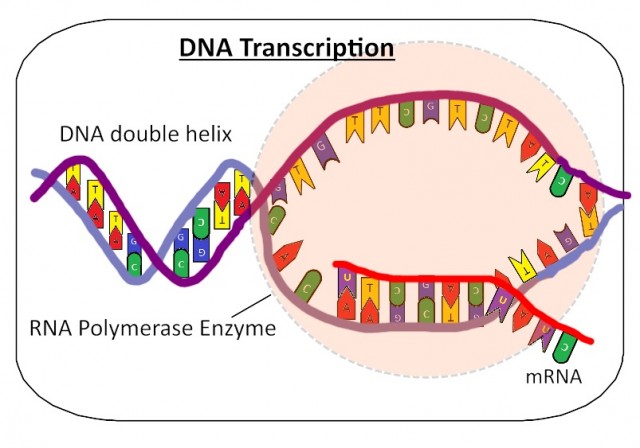Transcription of mRNA from DNA
 Using an animated visualisation of RNA polymerase students will learn how to describe the process of translation in simple terms. In order to do this a good knowledge of the structure of RNA is important. The first activity covers these basic facts and the last part of the lesson uses an IB style question as a plenary activity.
Using an animated visualisation of RNA polymerase students will learn how to describe the process of translation in simple terms. In order to do this a good knowledge of the structure of RNA is important. The first activity covers these basic facts and the last part of the lesson uses an IB style question as a plenary activity.
Lesson Description
Guiding Questions
How does the cell make mRNA from its DNA?
Which enzymes are involved?
Activity 1 - Distinguish between DNA and RNA molecules.
This diagram in the ![]() DNA and RNA structure students worksheet shows clearly the differences between the structure of DNA and RNA.
DNA and RNA structure students worksheet shows clearly the differences between the structure of DNA and RNA.
Use this diagram complete the simple questions
Activity 2 - Animated visualisation
This is the most wonderful animated visualisation of RNA polymerase enzyme in action. It make you ask, what is that, how can it move so quickly. The video has been made using the latest data and was created to raise awareness, educate and promote DNA science to the wider community, coinciding with the 50th anniversary of the discovery of the double helix. (Drew Berry).
Activity 3 Improving Answers in IB Exam Questions
In five minutes, write a quick answer to the question below.
Outline the process which results in the formation of a strand of mRNA. Include details of how the genetic code is preserved.
(Total 5 marks)
Here is an example of a typical student response.
The process that makes RNA is called transcription.
RNA nucleotides are added by the enzyme RNA polymerase.
The base A joins to T and C joins to G
One single stranded RNA molecule is produced in the process.
The genetic code is preserved because the bases pair up in a special way.This exam answer achieves two or three marks, but it needs to be more precise in the detail for 5 marks.
The Marks Achieved are ....
- the process is transcription
- RNA polymerase is the enzyme responsible;
- description of mRNA is correct;
The process that makes RNA is called transcription. (Better to say mRNA )
RNA nucleotides are added by the enzyme RNA polymerase.
The base A joins to T and C joins to G (Too Vague - and no mention of Uracil)
One single stranded RNA molecule is produced in the process.
The genetic code is preserved because the bases pair up in a special way. (Too Vague)
What improvements could be made?
It is usually good to start the longer questions with a simple definition.
Always link the structures with their functions, especial enzymes in this answer.
Give precise details, 'bases pair up in a special way' is a bit too vague.
This is an example of a possible mark scheme.
- The process which forms a strand of mRNA is called transcription.
- mRNA is a single stranded molecule made during transcription (from RNA nucleotides.)
- DNA is a double stranded molecule in the form of a double helix.
- The enzyme RNA polymerase unzips and unwinds the two strands of DNA.
- The Enzymes RNA polymerase then make a complementary strand of RNA using one strand of DNA as a template. (the antisense strand)
- Complementary base pairing ensures that an exact copy of the gene is made on the mRNA
- The DNA base adenine pairs with uracil on the RNA, thymine (on DNA) pairs with adenine, cytosine with guanine (and guanine with cytosine.)
- Once the mRNA strand has been copied the two DNA strands join together once again and the DNA reforms the double helix structure.
Teachers notes
This is a simple lesson beginning with a few simple facts about RNA and DNA using the worksheet in activity 1. Hopefully this will be followed by something of a "wow" factor with the video of RNA polymerase in activity 2. The video illustrates the difficulty of explaining complex processes in simple terms.
The final activity tries to help students to learn, and write down some of the key points about transcription. It is envisaged that each section will be revealed to students once they have had time to attempt that part themselves.
Translation is diliberately ignored in this lesson. Students often confuse the two processes in exams. Dealing with each one separately will hopefully help to avoid confusion.
It is important to note that for HL students there are more enzyme names to learn, and some extra details of the formation of the mRNA molecule. These will be covered in the HL lesson on protein synthesis later.
Further ideas
There is a great website called DNA>RNA>Protein where students can enter a DNA code and see how this turns into mRNA and then a polypeptide chain. It's a lovely illustration of the process.
This Netlogo protein synthesis model shows the effects of different types of mutation on the amino acids in the proteins produced by a gene. It is really nice to illustrate that a single base deletion can cause more changes to a protein than a base substitution.

 IB Docs (2) Team
IB Docs (2) Team
